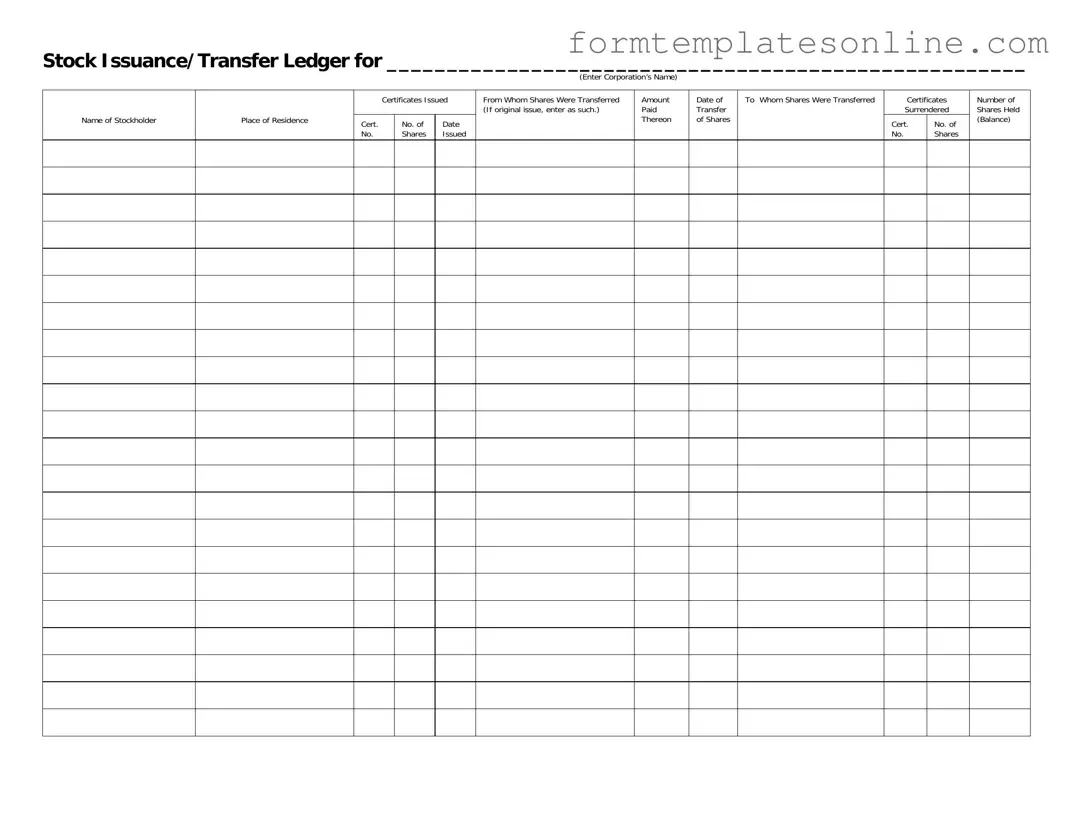What is a Stock Transfer Ledger form?
The Stock Transfer Ledger form is a record-keeping document used by corporations to track the issuance and transfer of stock shares. It provides a detailed account of stockholders, the number of shares issued, and any transfers that occur between individuals or entities. This form is essential for maintaining accurate ownership records and ensuring compliance with corporate regulations.
What information is required on the Stock Transfer Ledger form?
The form requires specific details, including the corporation's name, the name and place of residence of the stockholder, the certificates issued, the certificate numbers, the number of shares issued, and the details of any transfers. It also asks for the amount paid for the shares, the date of transfer, and the certificates surrendered. Lastly, it includes a section for the number of shares held after the transfer.
Why is it important to maintain a Stock Transfer Ledger?
Maintaining a Stock Transfer Ledger is crucial for several reasons. First, it helps ensure that the corporation has accurate records of stock ownership, which is vital for voting rights and dividend distributions. Second, it serves as a legal document that can be referenced in case of disputes regarding ownership. Lastly, it aids in compliance with state and federal regulations governing corporate governance and reporting.
Who is responsible for completing the Stock Transfer Ledger form?
The responsibility for completing the Stock Transfer Ledger typically falls on the corporation's secretary or another designated officer. This individual must ensure that all information is accurate and up to date. It is also advisable for stockholders to verify their information periodically to avoid discrepancies.
How often should the Stock Transfer Ledger be updated?
The Stock Transfer Ledger should be updated each time there is a stock issuance or transfer. This includes recording new shares issued to stockholders, as well as any transfers of shares between individuals or entities. Keeping the ledger current helps maintain the integrity of the corporation's records and supports smooth operations.
Can the Stock Transfer Ledger be used for electronic records?
Yes, the Stock Transfer Ledger can be maintained electronically, provided that the electronic format complies with applicable laws and regulations. Many corporations opt for digital record-keeping systems, which can streamline the process of tracking stock transactions and make it easier to access and manage records. However, it is important to ensure that electronic records are secure and backed up regularly.
What should be done if there is an error in the Stock Transfer Ledger?
If an error is discovered in the Stock Transfer Ledger, it should be corrected promptly. The corporation should document the correction, including the date and nature of the change. It's essential to maintain transparency and ensure that all stockholders are informed of any adjustments that may affect their ownership status. Keeping accurate records helps prevent misunderstandings and potential legal issues.

